Frequently Asked Questions
We’re here to answer your questions about Ozempic®
Hearing about Ozempic®, and want to know the facts? Find out below.
Considering Ozempic®
Ozempic® is used along with diet and exercise to improve blood sugar in adults with type 2 diabetes.
There are a number of reasons that Ozempic® could be right for you if you have type 2 diabetes and you're struggling to lower your blood sugar and reach your A1C goal.

Ozempic® is proven to lower A1C.

Ozempic® lowers the risk of major cardiovascular events such as stroke, heart attack, or death in adults also with known heart disease.

Ozempic® may help you lose some weight.
Ozempic® is not for weight loss.
Ask your health care provider if Ozempic® is right for you. Download a discussion guide to help get the conversation started.
Ozempic® injection 0.5 mg, 1 mg, 2 mg is an injectable prescription medicine for adults with type 2 diabetes used along with diet and exercise to improve blood sugar (glucose). It also lowers the risk of major cardiovascular events such as stroke, heart attack, or death in adults with type 2 diabetes and known heart disease.
It is not known if Ozempic® can be used in people who have had pancreatitis. Ozempic® is not for use in people with type 1 diabetes. It is not known if Ozempic® is safe and effective for use in children under 18 years of age.
Ask your health care provider if Ozempic® is right for you. Download a discussion guide to help get the conversation started.
Ozempic® in the Media
All doses of Ozempic® are now available to retail pharmacies nationwide for appropriate patients with type 2 diabetes. However, pharmacies may experience normal delays given the time required to order the product from their local distribution center, and geographical variabilities.
No, do not share your Ozempic® pen with others, even if the needle is changed. You may give other people a serious infection or get a serious infection from them.
You should always follow your health care provider’s instructions and use your Ozempic® pen as prescribed.
Social media can play an important role in educating about type 2 diabetes and its management. However, it’s important to recognize that not all information about a medicine or disease on social media is accurate or reliable. If you have any questions about Ozempic® or your treatment plan, it’s important to talk to your health care provider. Never make any changes to your medicine or treatment plan without consulting them first.
Any information shared or sponsored by Novo Nordisk online is clearly identified.
Ozempic® is approved by the FDA for adults with type 2 diabetes to lower blood sugar, along with diet and exercise, and reduce the risk of major cardiovascular events such as heart attack, stroke, or death in adults with type 2 diabetes and known heart disease. People respond to medicines differently. That's why it is important to talk to your health care provider about any questions you may have about your treatment plan.
Ozempic® is not FDA approved for weight loss or chronic weight management.
At this time, Novo Nordisk has not conducted studies to evaluate the effect on weight after discontinuation of Ozempic®.
Learn more about A1C and weight data.
If you are interested in a medicine which is FDA-approved for chronic weight management from Novo Nordisk, learn more here.
Novo Nordisk is committed to responsible use of our medicines. Learn more by visiting semaglutide.com.
Some health care providers may offer telehealth services and virtual consultations to assess treatment options. Check with your health care provider to determine the availability of these services.
We cannot control which specific patients receive our prescription-only medicines. What we can do is ensure that we reinforce who our medicines are intended to treat, based on their medical trials and FDA-approved indications, in support of responsible use of these medicines. We take that responsibility seriously—and that is reflected in our communication and promotional efforts. You can learn more about our commitment to responsible use of our medicines by visiting semaglutide.com.
Ozempic® is approved by the FDA for adults with type 2 diabetes to lower blood sugar, along with diet and exercise, and reduce the risk of major cardiovascular events such as heart attack, stroke, or death in adults with type 2 diabetes and known heart disease.
No. We are aware that there are companies claiming to have availability of compounded Ozempic® or semaglutide. We want consumers to know that Novo Nordisk does not sell prescription-only medicine Ozempic®, or its active ingredient, semaglutide, for the purposes of compounding with other products.
We have not conducted studies to evaluate the safety and efficacy of Ozempic® when compounded with other ingredients. Novo Nordisk is the only company that has FDA approval to market Ozempic® and we supply it in a branded box that includes a proprietary pen and the FDA-approved prescribing information. Novo Nordisk does not make Ozempic® in a vial that comes with a separate syringe.
At Novo Nordisk, patient safety is a top priority. We cannot validate the safety or effectiveness of products claiming to contain semaglutide that are not one of our own branded products and are working to ensure broad public awareness on the difference between our FDA-approved products and other medicines being labeled as “semaglutide” and sold by such entities.
Learn more about our commitment to responsible use of our medicines by visiting semaglutide.com.
Novo Nordisk is working with the US Food and Drug Administration (FDA) and has alerted the public that a counterfeit Ozempic® (semaglutide) injection pen was found in the US during the month of February 2023. The counterfeit product appears to have contained another type of diabetes medication that works differently than Ozempic®, which reportedly led to an adverse reaction. The safety or efficacy of counterfeit products cannot be assured, and they should not be used. Potential risks of taking a counterfeit medicine include serious adverse events.
Please see the pictures and details below to identify differences between an authentic FDA-approved Ozempic® pen in the US and counterfeit product. You can also learn more about how to identify authentic FDA-approved Ozempic® here.
Authentic Ozempic® Pens
With Cap

The Ozempic® pen has a blue dial and gray end cap, which doesn’t expand out when dialed.
The dose amount and/or “-“ is shown in the dose dial window.
Counterfeit Product
With Cap

This counterfeit pen has a white dial and purple end cap. The label on this pen may be of poor quality.
Without Cap

The Ozempic® pen has a gray cover over the medicine cartridge.
Without Cap

Numbers are seen around the medicine cartridge.
Incorrect scale that expands when setting the dose.
Authentic Ozempic® Carton
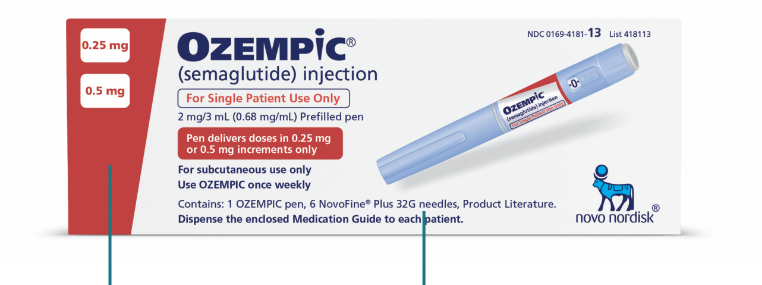
Authentic box has appropriate NDC and batch/lot numbers.
An authentic box will include 4 needles, except the Ozempic® 0.25/0.5 mg dose carton, which has 6 needles.
Counterfeit Carton
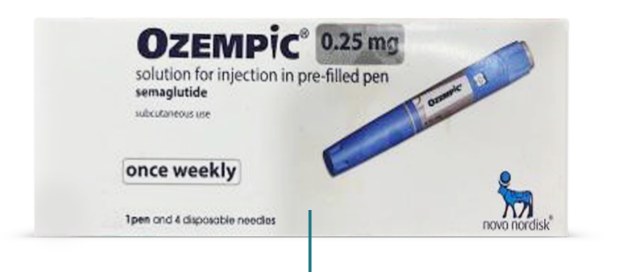
The counterfeit box is missing content (or text), such as 0.5 mg dose and “for single patient use only,” along with incorrect or missing lot/batch numbers.
May also contain misspellings and may not have tamper-resistant markings.
No—other Novo Nordisk products exist that contain semaglutide. If you are not sure which semaglutide product may be right for you, you should contact your health care provider to discuss your treatment options.
How Ozempic® Works
Ozempic® provides powerful A1C reduction.a
A majority of adults taking Ozempic® reached an A1C under 7% and maintained it.b
aIn 2 different studies, adults lowered A1C, on average, by:
- Ozempic®: 1.4% (0.5 mg) and 1.6% (1 mg) vs placebo: 0.1%
- Ozempic®: 1.9% (1 mg) and 2.1% (2 mg), taking 1 or 2 diabetes pills
from a starting average A1C of 8.0% and 8.9%, respectively.
bIn the same 2 studies, the majority of people reached an A1C under 7%:
- Ozempic®: 73% (0.5 mg) and 70% (1 mg) vs placebo: 28%
- Ozempic®: 56% (1 mg) and 64% (2 mg)
The American Diabetes Association (ADA) recommends that a reasonable goal for most adults with type 2 diabetes is an A1C less than 7%. Your health care provider will tell you what goal is right for you.
Yes. A study showed that in adults with type 2 diabetes and known heart disease, Ozempic® lowers the risk of major cardiovascular events such as stroke, heart attack, or death.
Non-insulin Ozempic® works with your body’s own ability to lower blood sugar and A1C. Ozempic® helps your body release its own insulin. And it's designed to respond when your blood sugar rises.
Ozempic® works in 3 ways to lower blood sugar:
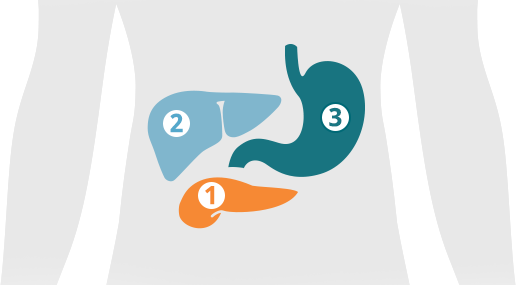
1
Helps your pancreas produce more insulin when your blood sugar is high
2
Helps prevent your liver from making and releasing too much sugar
3
Slows down food leaving your stomach
Savings & Support
With the Ozempic® Savings Card, eligible patients may pay as little as $25 for a 1-month, 2-month, or 3-month supply for up to 24 months.a
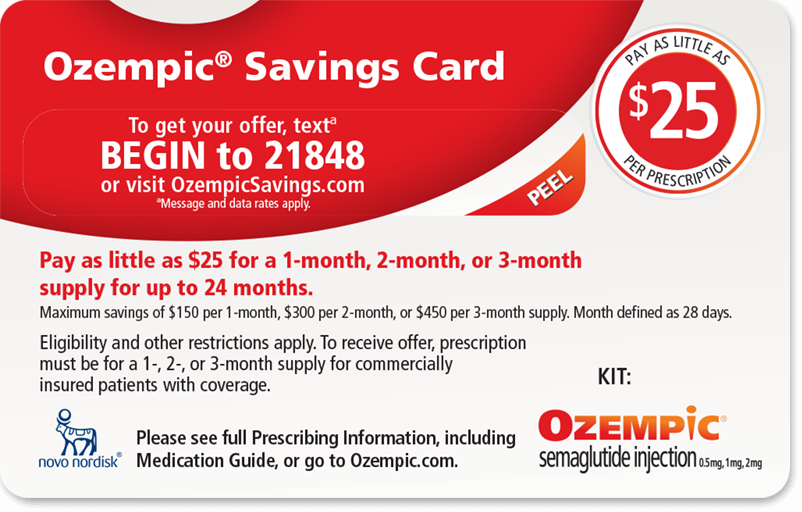
ªSavings card offer applies to eligible commercially insured patients with coverage for Ozempic®. Maximum savings of $150 for a 1-month prescription, $300 for a 2-month prescription, and $450 for a 3-month prescription. Month is defined as 28 days. Offer is good for up to 24 months. Eligibility and other restrictions apply.
Look up your co-pay and see how much Ozempic® will cost you: Find out now. In the U.S., eligible patients with private or commercial coverage for Ozempic® can access a savings card and pay as little as $25 for a 1-month, 2-month, or 3-month supply of Ozempic® for up to 24 months.a
Health care systems vary from country to country, which can result in different list prices. However, it’s important to note that a drug’s list price does not always reflect the actual out-of-pocket cost for a patient, which is determined based on specific insurance coverage and region.
aSavings card offer applies to eligible commercially insured patients with coverage for Ozempic®. Maximum savings of $150 for a 1-month prescription, $300 for a 2-month prescription, and $450 for a 3-month prescription. Month is defined as 28 days. Offer is good for up to 24 months. Eligibility and other restrictions apply.
With Ozempic® you get access to TexT2Connect—a free savings and support program. After signing up you’ll get text support with reminders, inspiration, and resources to help you start and stay on Ozempic®.
Text BEGIN to 21848 to get started.
Message and data rates may apply. Check with your mobile service provider. See Terms and Conditions of Use.
Give us a call for one-on-one live support from a Diabetes Health Coach—and to learn more about taking Ozempic®.
Call 1-866-696-4090 Monday through Friday, 9:00 am to 6:00 pm ET.
You can speak with a Diabetes Health Coach by calling 1-866-696-4090.
The Diabetes Health Coach will be happy to answer your questions about Ozempic®.
Taking Ozempic®
You take Ozempic® once-weekly with an Ozempic® pen, as prescribed and instructed by your health care provider. Read the Medication Guide and Instructions for Use that comes with Ozempic® for additional information. For questions, you should speak with your health care provider.
Your health care provider should show you how to use Ozempic® before you use it for the first time. Ozempic® is injected under the skin (subcutaneously) of your stomach (abdomen), thigh, or upper arm. Do not inject Ozempic® into a muscle (intramuscularly) or vein (intravenously).
Ozempic® is safe and effective when used as indicated for the treatment of adults with type 2 diabetes to lower blood sugar, along with diet and exercise, and reduce the risk of major cardiovascular events such as heart attack, stroke, or death in adults with type 2 diabetes and known heart disease.
See the Prescribing Information and Medication Guide. For medical advice about side effects, talk with your health care provider. You may also report side effects to the FDA at 1-800-FDA-1088.
When taken as instructed, Ozempic®, along with diet and exercise, may help lower your blood sugar and A1C.
Ozempic® can lower the risk of major cardiovascular events, such as stroke, heart attack, or death in adults with type 2 diabetes and known heart disease.
Ozempic® may help you lose some weight. Ozempic® is not for weight loss.
While taking Ozempic®, you may experience some side effects.
The most common side effects of Ozempic® may include:
Nausea
Diarrhea
Stomach (abdominal) pain
Vomiting
Constipation
With any medicine, it’s very important to talk to your health care provider about side effects—talk to yours about any side effect that bothers you or doesn't go away.
If you experience nausea, here are some general nausea tips that you might find helpful:
Eat bland, low-fat foods, like crackers, toast, and rice
Eat foods that contain water, like soups and gelatin
Avoid fried, greasy, or sweet foods
Avoid lying down after you eat
Go outdoors for fresh air
Eat more slowly
Drink clear or ice-cold drinks
For a complete list of possible side effects of Ozempic®, see Prescribing Information and Medication Guide. For medical advice about side effects, talk with your health care provider. You may report side effects to the FDA at 1-800-FDA-1088.
Ozempic® has been studied across 12 different clinical trials and has been on the market for 5 years. Please click here for the safety profile and talk to your health care provider.
See the Prescribing Information and Medication Guide. For medical advice about side effects, talk with your health care provider. You may also report side effects to the FDA at 1-800-FDA-1088.
Ozempic® is taken once a week, exactly as prescribed by your health care provider.
Getting started

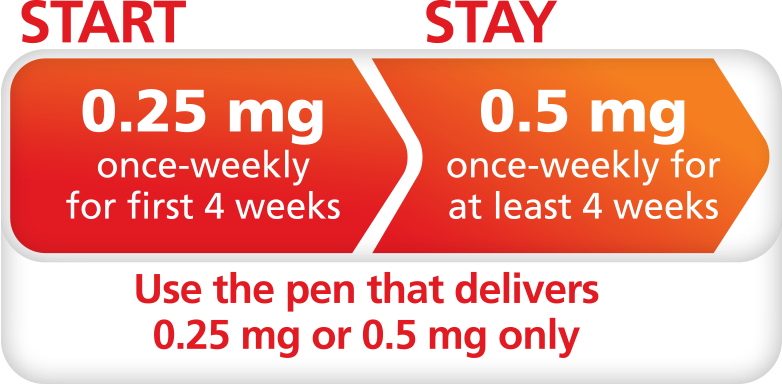
The beginning dose is 0.25 mg once a week for the first 4 weeks. This will help give your body a chance to get used to the medicine.
At Week 5, your health care provider will increase the dose to 0.5 mg once a week.
Additional control

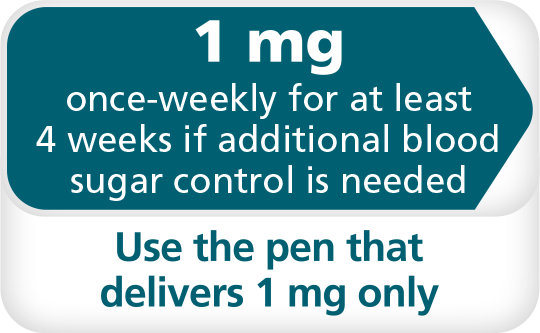

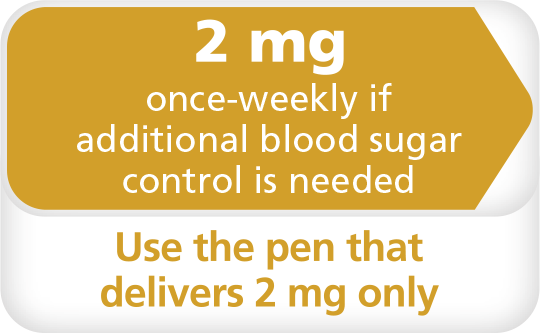
Your A1C needs may shift as your type 2 diabetes changes. That’s why Ozempic® offers pens that deliver doses of 1 mg or doses of 2 mg to give you additional A1C control. And while your dose may change, nothing will change about how you take Ozempic®—the 1 mg and 2 mg dose pens are the same as the pen you already use.
The maximum dose of Ozempic® is 2 mg once a week. Always follow your health care provider's instructions on how to dose Ozempic®.
How to store your Ozempic® pen
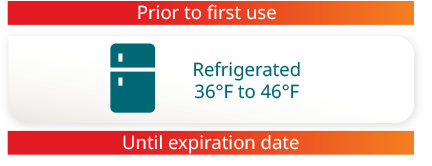
Store your new, unused Ozempic® pens in the refrigerator between 36°F to 46°F (2°C to 8°C).

Store your pen in use for 56 days at room temperature between 59ºF to 86ºF (15ºC to 30ºC) or in a refrigerator between 36°F to 46°F (2°C to 8°C).
You should take Ozempic® exactly as prescribed by your health care provider. If you have any questions about your A1C and blood sugar goals, or changes to your treatment plan, talk with your health care provider. Never make changes to your treatment plan without consulting your health care provider first.
Living With Type 2 Diabetes
Type 2 diabetes occurs when the body does not make enough insulin or doesn’t respond to insulin properly. To understand type 2 diabetes, you need to know what insulin is and why your body needs it.
The main ingredient in Ozempic® is called semaglutide, a man-made version of the human GLP-1 molecule, with some changes.
GLP-1, or glucagon-like peptide-1, is a natural hormone that helps your body keep blood sugar in balance. GLP-1 treatments work like this naturally occurring hormone.
Ozempic® and My Type 2 Transformation offer videos, recipes, and more to help you learn about healthy eating. Ozempic®, along with diet and exercise, can help lower A1C for adults with type 2 diabetes.
Ozempic® and My Type 2 Transformation offer videos and more to help you stay active. Ozempic®, along with diet and exercise, can help lower A1C for adults with type 2 diabetes.
Ozempic® and My Type 2 Transformation offer videos and more to help you learn techniques for dealing with stress and staying motivated as you manage your type 2 diabetes.

